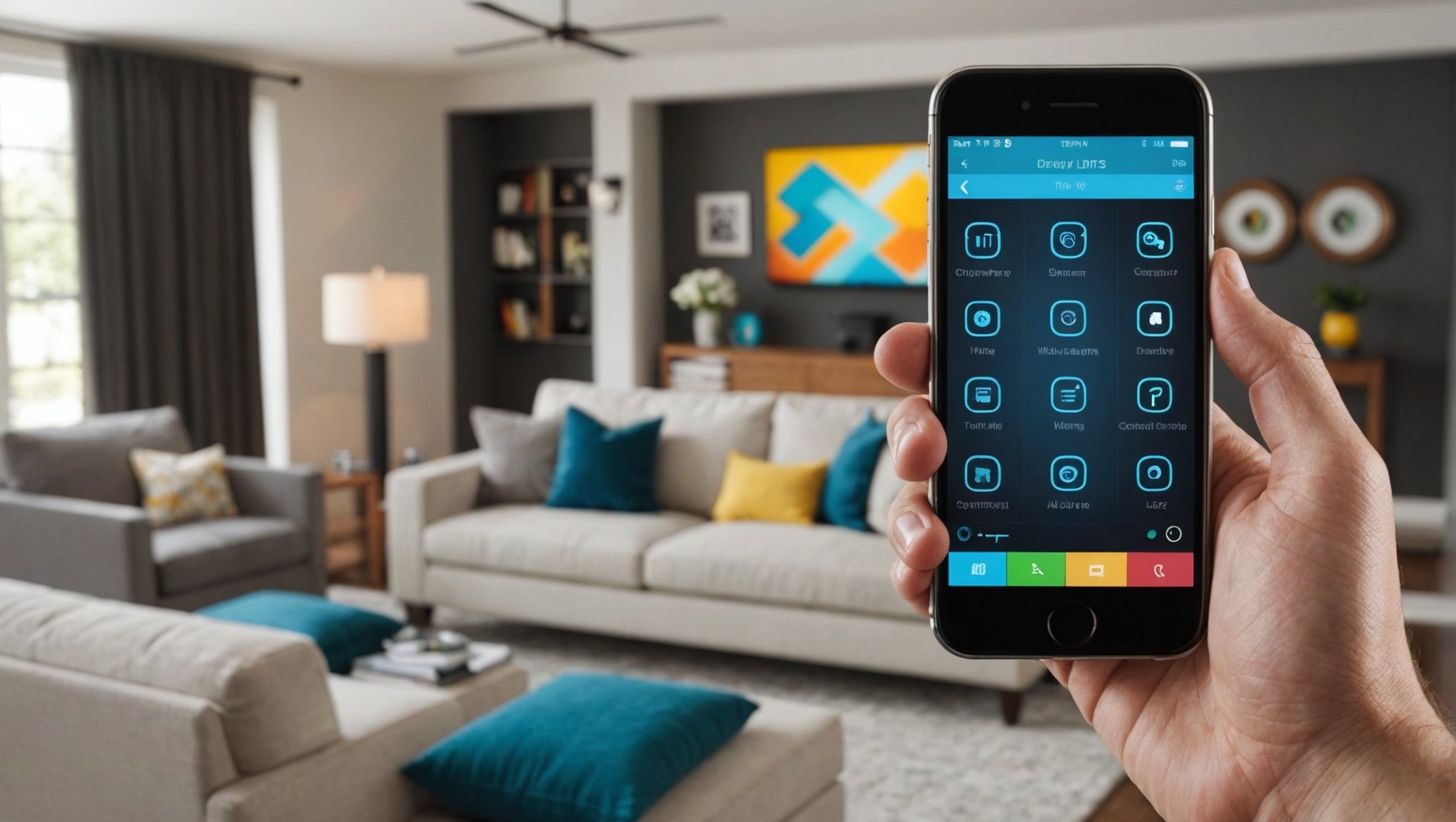Smartphone apps are revolutionizing home automation, offering convenience at your fingertips. With the right tools, managing household tasks becomes effortless, enhancing your lifestyle. Whether you aim to control lighting, security, or energy consumption, diverse apps cater to every need. Discover the ultimate smartphone apps that will streamline your home automation experience, making it smarter, more efficient, and tailored to your preferences. Embrace the future of living where technology seamlessly integrates into daily routines.
Overview of Home Automation Apps
Home automation has become an integral part of modern living, offering convenience, efficiency, and enhanced control over various household functions. At the heart of this technological advancement are Home Automation Apps, which serve as the central hub for Smart Home Management. These apps allow users to control and monitor their smart devices seamlessly, often from the palm of their hand.
Also read : Top Techniques for Optimizing Your Smartphone for Quick and Effective Document Scanning
Smartphone apps are crucial in managing smart devices, acting as a bridge between the user and their interconnected home systems. They enable users to perform tasks such as adjusting lighting, regulating thermostats, and even monitoring security cameras remotely. The convenience of having everything accessible through a single interface cannot be overstated, as it simplifies the management of multiple devices and enhances the overall user experience.
There are various types of apps available for home automation, each catering to different needs and preferences. Some apps focus on specific functions, like lighting or security, while others offer comprehensive solutions covering all aspects of smart home management. Popular apps often integrate with voice assistants like Alexa or Google Assistant, providing an additional layer of convenience through voice commands. As technology continues to advance, the capabilities of home automation apps are expected to expand, offering even more innovative solutions for smart home enthusiasts.
Topic to read : Discover amazing deals on certified used samsung phones
Top Smartphone Apps for Home Automation
Navigating the realm of home automation can be simplified with the right smartphone apps. Here, we present a curated list of the best home automation apps that stand out for their functionalities and compatibility with smart devices.
Key Apps and Their Functionalities
-
Samsung SmartThings: Known for its broad compatibility, SmartThings allows users to control a wide range of smart devices from different manufacturers. Key features include automation routines and real-time device status updates.
-
Google Home: This app excels in integrating Google Assistant for voice commands. It offers a user-friendly interface for managing devices like lights, cameras, and thermostats, making it one of the top smart device apps.
-
Apple HomeKit: Ideal for Apple users, HomeKit provides seamless integration with Siri. It offers robust security features and supports a variety of smart home devices through a single app.
- Amazon Alexa: While primarily a voice assistant, Alexa’s app serves as a hub for controlling smart devices. Its strength lies in its ability to create complex routines and manage a diverse range of compatible products.
These apps not only enhance the smart home experience but also ensure that users can effortlessly manage their devices, regardless of the brand or type, all from their smartphones.
Detailed Reviews of Leading Apps
Delving into Home Automation App Reviews reveals a wealth of insights into user experiences and app functionalities. Let's explore some leading apps in this space.
Samsung SmartThings
Overview and Key Features: Samsung SmartThings stands out for its extensive compatibility with various smart devices. It offers automation routines and real-time device status updates, making it a versatile choice for smart home management.
User Ratings and Reviews: Users consistently praise its ease of use and integration capabilities. However, some users have noted occasional connectivity issues.
Pros and Cons:
- Pros: Broad compatibility, user-friendly interface, robust automation features.
- Cons: Connectivity issues reported by some users.
Google Home
Overview and Key Features: Google Home integrates seamlessly with Google Assistant, offering a straightforward interface for managing smart devices like lights, cameras, and thermostats.
User Ratings and Reviews: The app receives high marks for its intuitive design and reliable performance. Some users, however, wish for more advanced customization options.
Pros and Cons:
- Pros: Intuitive interface, reliable performance, voice command integration.
- Cons: Limited advanced customization.
Apple HomeKit
Overview and Key Features: Tailored for Apple users, HomeKit provides seamless Siri integration and strong security features, supporting a variety of devices.
User Ratings and Reviews: Users appreciate the security and ease of use, though some find device compatibility limited.
Pros and Cons:
- Pros: Strong security, seamless Siri integration.
- Cons: Limited device compatibility.
Setting Up Home Automation Apps
Setting up home automation apps can be straightforward with a clear App Installation Guide. Begin by downloading the app from your device's app store. Once installed, open the app and create an account if required. Most apps will guide you through connecting your smart devices. Ensure that your devices are compatible with the app for smooth integration.
Step-by-Step Guide
-
Download and Install: Locate the app in your app store and download it. Follow the on-screen instructions to install.
-
Account Setup: Open the app and register or log in. This step is crucial for accessing all features.
-
Device Pairing: Use the app's device management section to add your smart devices. Ensure they are in pairing mode and follow the prompts.
Common Troubleshooting Tips
- Connectivity Issues: Ensure your Wi-Fi is stable and devices are within range. Restarting the app or device can resolve minor issues.
- Compatibility Checks: Verify that your devices are supported by checking the app's compatibility list.
Best Practices
- Regular Updates: Keep your app and devices updated for the best performance.
- Secure Networks: Use a secure Wi-Fi network to protect your smart home setup.
Maximizing Your Home Automation Experience
To truly benefit from home automation, consider these Home Automation Tips and Smart Home Optimization strategies. Begin by fine-tuning your app settings. Adjust notifications to receive timely updates on your devices' status, ensuring you're always informed without being overwhelmed. Customise automation routines to suit your daily schedule, enhancing convenience and energy efficiency.
Integrating multiple apps can seem daunting, but it's essential for a unified smart home experience. Use platforms that support cross-compatibility, allowing different apps to work together seamlessly. For example, linking your lighting app with a security system can automate lights to turn on when motion is detected, providing both security and comfort.
Regular updates are crucial. They not only introduce new features but also patch security vulnerabilities. Ensure both your apps and devices are updated to maintain optimal performance and safety. Device compatibility is equally important; check that new devices you purchase are supported by your existing system to avoid integration issues.
By following these strategies, you can enhance your smart home setup, making it more efficient and enjoyable. Embrace these tips to transform your home into a well-oiled smart ecosystem.
Comparison of App Performance
When conducting a Home Automation App Comparison, several criteria are essential to evaluate app performance. Speed, user interface, and features are primary factors influencing user experience. A fast app ensures seamless operation, while an intuitive user interface makes navigation effortless. Comprehensive features cater to diverse user needs, enhancing the overall utility of the app.
Criteria for Evaluating App Performance
- Speed: Users expect quick response times, especially when controlling multiple devices simultaneously. Apps that lag can frustrate users and disrupt the smart home experience.
- User Interface: A well-designed interface facilitates ease of use, enabling users to access functions without confusion. Clear layouts and intuitive navigation are critical components.
- Features: The range of functionalities offered by an app determines its adaptability to various home automation scenarios. Apps with extensive features provide more value to users.
Side-by-Side Comparison of Key Apps
- Samsung SmartThings: Known for its broad compatibility, it excels in automation but may face occasional connectivity issues.
- Google Home: Offers a user-friendly interface and reliable performance, though it lacks advanced customization.
- Apple HomeKit: Praised for security and Siri integration, yet some find its device compatibility limited.
Future Trends in Home Automation Apps
As technology advances, the future of home automation is set to transform how we interact with our living spaces. Emerging technologies are poised to redefine smart home trends, offering enhanced capabilities and integrations.
Emerging Technologies in Home Automation Apps
The integration of AI and machine learning is at the forefront of this evolution. These technologies enable smarter decision-making by analysing user behaviour and preferences, leading to more efficient automation. For example, AI can learn your routine and adjust lighting or temperature settings automatically, enhancing convenience and energy savings.
Predictions for the Evolution of Smart Home Applications
Future smart home applications are expected to offer even greater interoperability between devices. This means seamless communication across different brands and platforms, creating a more cohesive smart home environment. Additionally, voice recognition and natural language processing will become more sophisticated, allowing for more intuitive voice commands and interactions.
Impact of AI and Machine Learning on Home Automation Efficiency
AI and machine learning not only improve user experience but also boost the efficiency of home automation systems. By predicting maintenance needs and optimising resource usage, these technologies contribute to a more sustainable and cost-effective smart home. As these trends develop, the potential for innovation in home automation apps is virtually limitless.











